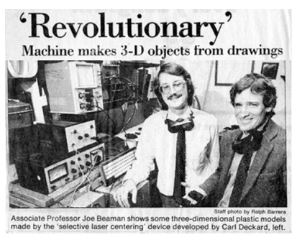by Chantal Petgrave, 3D Printing peer tutor, Humanities & Social Sciences Library
Most people are unaware of the fact that additive manufacturing technology is not new process and has been around since the Reagan era. In 2009 when the Fused Deposition Modeling (FDM) patents expired, 3D printing became such a popular topic that many people easily believed that it was a brand new innovation. It also gained such a wide media coverage because people often imagined that FDM was the only additive manufacturing technique, even though the stereolithography technique was patented in the 1980s. Here is a quick timeline of the history of 3D printing to today.
1981–1999: The Birth of Additive Manufacturing:
~1981:
The foundation for 3D printing was load when Hideo Kadama created a functional rapid prototyping system. This system used photopolymers (a type of polymer that changes its physical properties when exposed to light), where a solid printed model was built up in layers.
1984:
Charles Hull invested stereolithography, which let designers create 3D models and later realistic objects by using digital data. In 1992, Charles Hull’s company (3D Systems) created the world’s first stereolithographic apparatus machine, which made it possible to fabricate complex parts, layer by layer, at a more efficient pace. These machines weren’t perfect in their beginning stages, but the potential they possessed was undeniable.
1999–2010: 3D Printing’s Teenage Years:
Early 2000s:
This was a great time for 3D printing in the medical sense. In just 10 short years, scientists from different institutions and start-ups fabricated a functional miniature kidney, build a prosthetic leg with complex component parts that were printed within the same structure, and bio-printed the first blood vessels using only human cells.
~ 2006:
The first SLS machine became commercially viable in 2006, which made it easier to manufacture industrial parts on demand. Also, the barriers of entry for designers and investors started to dissipate once collaborative co-creation services such as Shapeways, a 3D printing marketplace where designers can get feedback from consumers and other designers, and Makerbot, which provided open-source DIY kits for makers to build their own 3D printers and products.
2011–Present Day: 3D printing today:
Today the price of 3D printers has rapidly decreased and the accuracy of 3D printing has improved, where innovators are pushing the envelope in ways that Charles Hull could only image.
Examples of Innovation:
- 2014: NASA bringing a 3D printer to outer space, helping to create the first “non-Earth originated” 3D printed object
- 2011: Cornell University began building a 3D food printer!
3D printing hasn’t reached its limits and with future generations there is much it has yet to offer. With every new project, amazing stories are just waiting to be written…
For more information on 3D printing, see Chantal’s post 3D printing 101 – an introduction, that appeared on Library Matters in January 2017.


